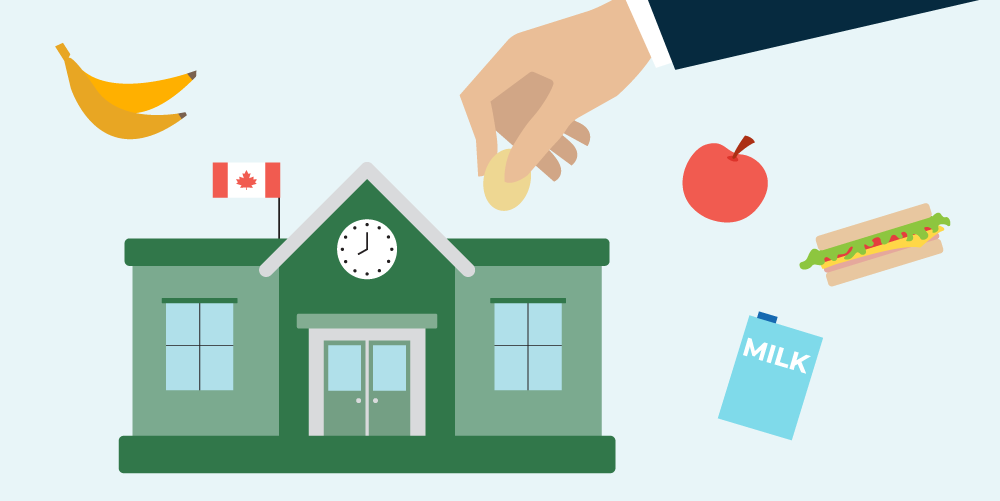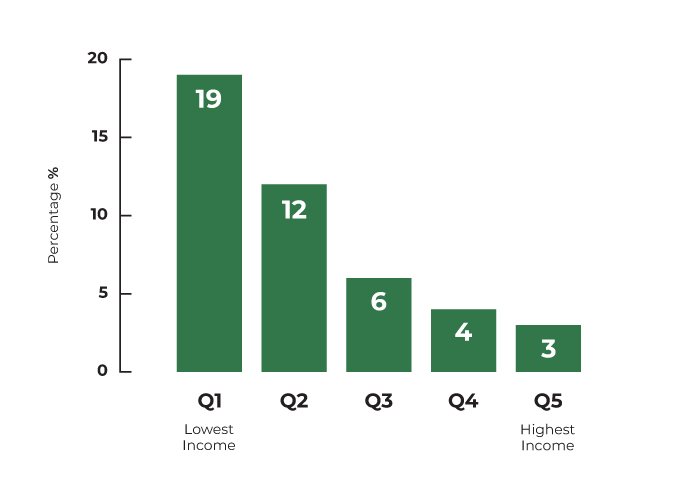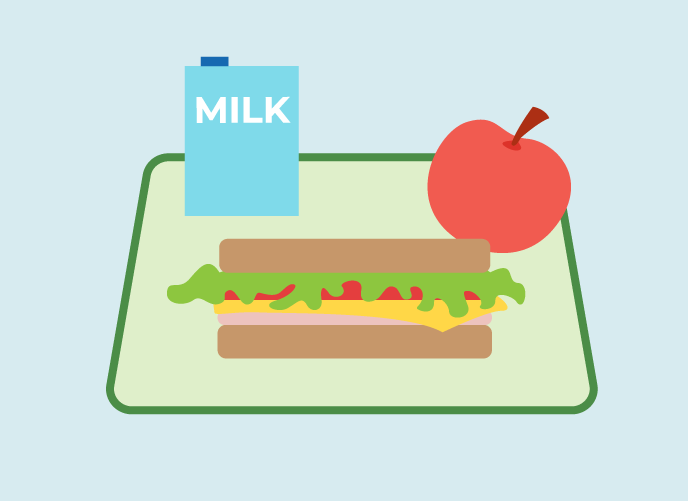Healthy eating policies
Food provision
 Food provision, as a policy action, refers to healthy food service policies implemented in government-funded and private settings to encourage healthy food choices.
Food provision, as a policy action, refers to healthy food service policies implemented in government-funded and private settings to encourage healthy food choices.- School-based nutrition programs and meal standards increase consumption of fruits, vegetables, and water (vs. sugar-sweetened beverages).
- Limiting in-school food competition between unhealthy and healthy food options, implementing nutrition policies, and improving meal and menu standards within schools decreases unhealthy snacks, saturated fats, and sugar-sweetened beverage consumption.
- Accessible and free universal healthy school meals may increase food security and healthy diets among students.
- Fruit and vegetable availability and healthy catering options within schools and workplaces increases fruit and vegetable consumption and healthy eating practices.
- There is a need for primary studies to:
- collect and report data for diverse populations in differing contexts
- study effectiveness of nutrition policies on food consumption over the long-term
- understand factors that influence food-choices in diverse population groups, particularly those facing food insecurity
Percentage of population 12+ experiencing food insecurity, by income quintile, 2021
Food insecurity increases as income decreases. 19% of people in the lowest income quintile report food insecurity, compared to 3% in the highest income quintile.

19% of people in the lowest income quintile face food insecurity
Data source: Canadian Community Health Survey, 2021

Free healthy school meals increase overall healthy diets
Provincial/territorial healthy eating policy analysis
The degree of policy adoption is HIGH – all provinces and territories have at least one policy on healthy eating and food provision. Most provinces and territories have adopted a similar approach to food provision policies, and most policies cite Canada’s Food Guide as a benchmark for healthy food options.
Health Canada’s dietary guidelines recommend publicly funded facilities offer foods aligned with Canada’s Food Guide.
The most consistent food provision policies govern schools and childcare centres.
Examples of policies include the following:
- 11 provinces/territories have policies directing healthy food choices in childcare centres with most following Canada’s Food Guide (NL, NB, QC, MB, SK, AB, NT, YT, BC, NU, NS).
- Mandatory school food provision policies exist in seven provinces/territories (BC, ON, NB, NS, PE, YT, QC). Two provinces (MB, SK) have mandatory district-level guidelines. Recommended guidelines exist in the other three provinces (AB, NL, QC). No policies exist in NU and NT, although development of guidelines is reported to be underway.
- Yukon’s School Sale of Home Prepared Foods to the Public and Manitoba’s Community Schools Act encourages culturally relevant foods to be sold in schools and mandates healthy nutrition programs.
- Food provision policies that govern residential care facilities – including personal care homes, foster homes, youth centres, and addiction centres – exist in several provinces (MB, ON, NS, AB, SK, QC).
- Ontario requires service agencies to follow Canada’s Food Guide recommendations when implementing procedures and policies that affect persons with disabilities.
- British Columbia requires Healthier Choices in Vending Machines in Public Buildings.
- New Brunswick’s Local Food and Beverages Strategy, Ontario’s Local Food Act, and Quebec’s Food Policy encourages local procurement, public awareness of local food economies, and improved health through increased availability of fresh local food.
Municipal healthy eating policy analysis
The degree of policy adoption is HIGH – many municipal policies encourage healthy eating through food provision. These policies range from providing healthy food options in municipal buildings, to ensuring residents have access to locally grown produce.
Examples of policies include the following:
Households at risk of food insecurity
Those at the greatest risk of food insecurity are households that are of working age (18-44), have children, have variable job security, and lost employment or were forced to stop working due to the pandemic.1
- Hamilton’s Bylaw to License and Regulate Various Businesses requires residential care facility tenants are served sufficient food of good quality and adequate nutritional and caloric value.
- Several municipalities direct the sale and provision of healthy foods for city-run workplaces including the Hamilton Healthy Food and Beverage Policy, St John’s’ Healthy City Strategy, New Westminster, British Columbia’s Healthy Food Service Policy and Salaberry-de-Valleyfield’s Nutrition Policy.
- Some local governments have enacted policies restricting unhealthy food in recreation and sports facilities, including food that is available in vending machines, including Edmonton’s Operational Guidelines, Hamilton’s Healthy Nutritional Environments in City Recreational Facilities policy and Montreal’s borough of Côte-des-Neiges/Notre-Dame-de-Grâce Policy on Healthy Lifestyles.
- Multiple municipalities have outlined policies that promote local food production through community gardens including Edmonton, Whitehorse, Victoria, Vancouver, Calgary, Moncton, London, Charlottetown, Regina, Winnipeg, Peel, Hamilton, and Fredericton.
- Several municipalities encourage local, sustainable healthy food production and procurement including Quebec City’s Urban Agriculture Action Plan, Toronto’s Rethink Food Initiative and Thunder Bay’s Sustainable Environmental and Ethical Procurement.
![]() COVID-19 and food insecurity
COVID-19 and food insecurity
The COVID-19 pandemic has exacerbated food insecurity as 14.6% of people in Canada experienced household food insecurity in May 2020, an increase of 4.1% from 2017-2018.2
![]() Opportunities for action
Opportunities for action
Future policies that place a greater emphasis on individual or cultural preferences and practices rather than adopting a blanket approach to healthy eating would be advantageous.
Consultation on the National School Food Policy and a national school nutritious meal program is encouraged.
- Idzerda, L., Gariépy, G., Corrin, T., Tarasuk, V., McIntyre, L., Neil-Sztramko, S., … Jaramillo Garcia, A. What is known about the prevalence of household food insecurity in Canada during the COVID-19 pandemic: a systematic review. Health Promotion and Chronic Disease Prevention in Canada: Research, Policy and Practice, 42(5), 177-87. https://doi.org/10.24095/hpcdp.42.5.01
- Statistics Canada. (2020a). Food insecurity during the COVID-19 pandemic, May 2020. https://www150.statcan.gc.ca/n1/pub/45-28-0001/2020001/article/00039-eng.htm
